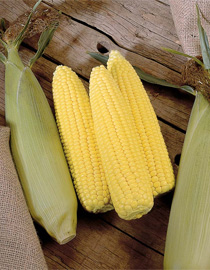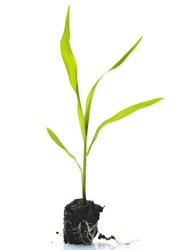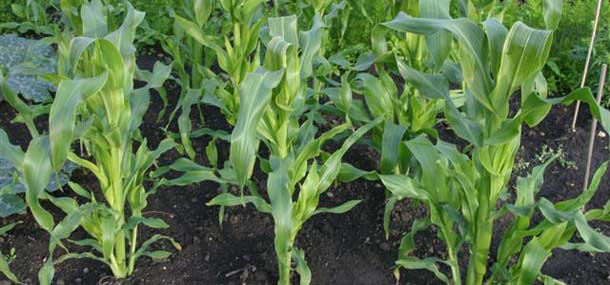
How to grow sweetcorn
With so many ways to enjoy this ever popular vegetable, there's nothing better than being able to serve up your own home grown produce, be it "corn on the cob" with lashings of butter or as part of a delicious salad.
Sweetcorn is easier to produce than most people would imagine, only requiring a bit of room to grow and anchor those tall stems that are a familiar sight in farmers' fields these days. Read our useful guide on how & when to grow sweetcorn below.
Varieties of sweetcorn

- Sweetcorn 'Lark' F1 Hybrid - This tendersweet variety is an RHS award winner and reliably produces large cobs.
- Sweetcorn 'Conquerer' F1 Hybrid - This supersweet variety is well adapted to our changeable summer weather. Produces long cobs with very few sideshoots.
- Sweetcorn 'Golden Gate' - Perfect for growing in cooler or wet soils, this sweet mid-season variety can be enjoyed barbecued, boiled or steamed.
- Sweetcorn 'Swift' F1 Hybrid- is a good all round variety, reliable germination rates and two to three sweet and tender cobs per plant, each on average a good 18cm long (7inches).
How to sow sweetcorn seed

Sow indoors from April onwards, ideally in individual coir pots or recycled toilet roll inners. This is to minimise the disturbance to the roots which sweetcorn will dislike.
If you wish to, you can sow the sweetcorn directly outside, but wait until May, once the weather has become milder and all risk of frost has passed. Plant two seeds together approximately one and a half inches deep, in blocks allowing 15 - 18 inches between each pair. Once the seedlings have germinated, remove the weakest plant and dispose of it.
Growing on sweetcorn
If you have grown your plants in individual pots then plant them out once they are at least 6 inches (15cm) high and all risk of frost has gone , again in blocks with 15 - 18 inches between each plant. Sweetcorn needs to be sown or planted out in blocks as it is pollinated by the wind, meaning that a single row is unlikely to have successful pollination and your crop will be greatly reduced. The bigger the block the better the pollination will generally be.

Sweetcorn also prefers reliably moist and well fertilised soil, digging in compost, or raking in a good quality fertilizer such as our Incredicrop ® and keeping the plants well watered throughout the growing season will help to ensure a good crop of tasty kernels. Applying a mulch of organic material will help keep weeds down and retain moisture during drier periods.
Sweetcorn can also be grown in large containers, provided they are in a good quality compost and are also fed regularly. This means that a few plants can be planted into one of our patio bags and grown at home in the back garden.
When to harvest sweetcorn

When the silky tassels on each cob have turned brown the corn is usually ready, however, it is best to check by peeling away the sheaf and pinching a kernel, id the juice inside is milky then the cob is ready to harvest, if it is clear, it is better to wait a little longer, if there is no liquid then you may have left it too late.
If at all possible, eat or cook immediately after harvesting, the natural sugars inside the kernels start to break down immediately after the cob has been twisted or cut away from the plant and so freshness is of the essence!
Quick guide:
Is sweet corn easy to grow?
Sweet corn is easier to grow than many people think. It can be grown in large containers, or the ground, and only requires a bit of room to anchor its tall stems. Plant it in 'blocks' rather than rows as it is pollinated by the wind.
How do you grow sweet corn?
Sow sweet corn seeds indoors from April, ideally in individual coir pots or recycled toilet roll inners to minimise root disturbance when it's time to plant out. Alternatively, wait until May and sow sweetcorn seeds directly outside once all risk of frost has passed.
When do you harvest sweet corn?
Corn is usually ready to harvest when the silky tassels on each cob have turned brown. Check by peeling away the sheaf and pinching a kernel. If the juice inside is milky, it's ready to harvest. If it's clear, wait a little longer.

Written by: Graham Ward
I've been gardening for as long as I can remember, my first earliest memory being planting seeds in my Grandfather's prestige flower bed and having a prize lettuce growing there, which he proudly left to show everyone.
Since then, gaining knowledge and experience from both my Grandfather and my Father, I've continued to garden, both as a hobby and later on as a professional gardener and landscaper for 12 years. I love all aspects of it, from the design and build, to the planting out of summer borders with plants you've either grown from seed or raised from plugs. Unusual varieties always catch my eye and I'm keen to try growing them, even if sometimes it means learning from my mistakes.
Sign Up For Exclusive Special Offers




© 2024 Thompson & Morgan. All rights reserved. A division of Branded Garden Products Limited.




